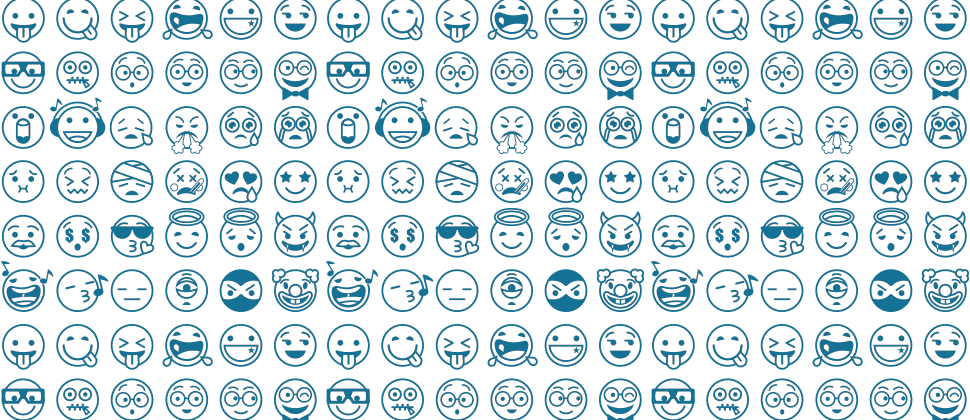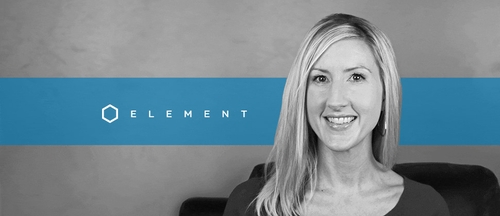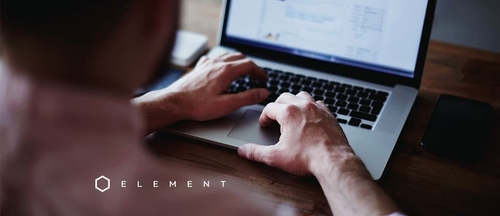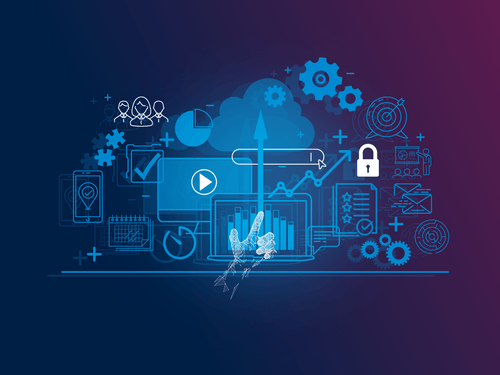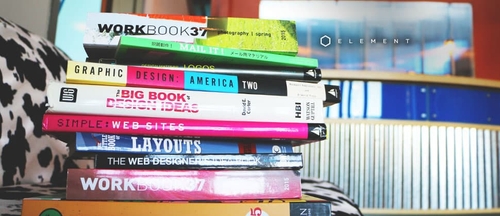Back when Kasey was just 18, text messages and chats sent from mobile phones were limited to drab black and white emoticons … then, like a beacon of pop culture light, came the emoji.
From the Japanese words “picture” and “character,” the emoji exploded onto the worldwide scene in 1999. Proof of emojis’ staying power, they’re still with us today. Users campaign for emojis they’re passionate about, and Apple continues to push the emoji game with their Animojis, which amazingly, “analyze more than 50 different muscle movements to mirror your expressions.” What a time to be alive!
Another sign of emojis’ power is their presence in marketing messages. Email marketing, social media posts, and even blog posts are often littered with them. But, how can brands use emojis without appearing as if they’re trying too hard? How can marketers pick the right emojis? More importantly, should all brands use emojis?
You’re in luck – because this article covers all that and a bag of chips.
Emojis for my brand: 😍 or 😵?
According to the Interwebs, there’s no shortage of brands using emojis to get their marketing messages across. As Wordstream says, “the use of emojis in email marketing messages increased 775% from 2015 to 2016.”
Apart from being prevalent, there is a literal ton of literature that suggests emojis are powerful communication tools:
- “Emoticons are effective in improving enjoyment, personal interaction and the perceived information richness of our messages.” [Via Neil Patel]
- “Looking at an emoji is far more gratifying than reading a word from the Oxford Dictionary.” [Via University of Missouri-St. Louis]
- “Emojis in a tweet can increase engagement by 25.4 percent. Emojis in a Facebook post can increase the number of likes by 57 percent and the number of comments and shares by 33 percent.” [Via HubSpot]
👐 down, emojis work. And, they’re effective for most brands, as long as that brand chooses their emojis wisely and uses them sparingly … we’ll get to that later.
First, let’s cover the basics. The following table reviews the multiple meanings of some of the most popular emojis.
Emojis, A to 💤
| Emojis | Name | Meaning |
| 👉
|
Right pointing hand
|
Used in place of a colon before a link in social media posts. Great for directing attention to links, coupon codes, and other must-read messaging.
|
| 👀
|
Eyes
|
Known colloquially as the “side eyes” emoji, Eyes implies that the reader is being watched, perhaps judgmentally, by the writer. It can also represent “pervy eyes” or “deceitful acts,” depending on the context. Finally, it can innocently mean that the writer is simply looking for something.
|
| 👏
|
Clapping hands
|
Generally used to convey appreciation, admiration, or digital applause, the clapping hands took on a different meaning in 2017 with users placing them between words to add emphasis. This phenomenon is called the “Ratchet Clap” or “emphasis clap.”
|
| 🙏
|
Person with folded hands
|
In the emoji’s native culture of Japan, folded hands unequivocally mean “thank you” or “please.” Others will take it to mean that the writer is praying, and yet another camp of conspiracy theorists believe this is the high five emoji.*
|
| 🙌
|
Raised hands
|
Known as the celebration emoji, these raised hands have evolved to carry a lot of different meanings. As BuzzFeed states, the literal meaning is “yay!” but mainly means, “Praise Oprah for this [insert awesome thing].”
|
| 😁
|
Grimacing face
|
Right at home in an “oops” follow-up email after a mistaken send, the grimacing face is synonymous with “I messed up” or “I’m about to ask you an annoying/huge favor … plz don’t hate me.”
|
| 🎉
|
Party popper
|
The go-to party emoji, the popper is often accompanied by the balloon , birthday cake , bottle with popping cork , confetti ball , or clinking glasses to celebrate an event or milestone: birthday, anniversary, riding a rollercoaster without puking, a bi-annual sale, etc.
|
| 🔥
|
Fire
|
This little flame can literally mean “hot,” or refer to being “lit.” As Merriam Webster says, “lit” has been slang for intoxicated for over a century, but has also come to mean “exciting” or “awesome.” The fire emoji is also prominent on Snapchat, appearing next to a contact on a “snapstreak” – a number of consecutive days spent snapping back and forth with the contact.
|
| ✨
|
Sparkle
|
The sparkle emoji is a cluster of four-sided stars with curved indentations. It often means that something is new, glamorous, clean, or shiny.
|
| 🚀
|
Rocket
|
This little launching rocket can mean many things, depending on context. Sometimes it means that the reader is about to “take off” and reach their goals, while other times it means that a product is fast and high-tech. It’s often used in conjunction with sci-fi pop culture references.
|
| 💣
|
Bomb
|
See fire emoji. Appearing as a teeny bomb with a lit fuse, this emoji means that something is “the bomb,” “lit,” or highly awesome or exciting.
|
| 🙋
|
Person raising one hand
|
Means “pick me,” “it’s me,” or, if you’re deep into the ‘net, “it me.”
|
| 🔒
|
Lock
|
Comes with the connotation of security and safety, or that the writer has their s%#@ “on lock.”
|
| ⏰
|
Clock
|
Often means it’s time for something, or that time is running out.
|
| 💀
|
Skull
|
Stands in for “dead” or “*dead*” and implies that the writer is “dying of laughter” or has been “slayed” by something amusing or humorous.
|
‘Mojis you might not have known were kinda gross
There is a growing list of emojis (🍑, 💦, 🍆, etc.) with secondary, totes-inappropriate meanings. You’ve been warned.
Picking emojis for your brand
Now that you know a few of the basics, it’s time to peruse the full list of emojis and pick a few that you’ll use consistently, and scope out others that might be good to use once in a blue moon.
For everyday usage: pick emojis that represent your brand. If you’re a bank, you might choose to use money 💵 or flying money 💸 in conjunction with certain topics, on particular social channels, or with a branded hashtag, i.e. #SaveMoreMoney.
For sometimes: for the most part, emojis that stand in for words or relate directly to your messaging work. If you’re running a swimsuit sale, let the 👙 stand-in for “swimsuit.” If you’re introducing a new lawn and garden product line, the seedling 🌿adds a pop of color.
For once in a while: it’s essential to not overuse trending emojis – no matter how hip your brand is, people will start seeing you as a try-hard. That’s no good.
How savvy users see you when you use 100 points 💯 too freakin’ much.
Target Audience & Platform Considerations
You may be concerned that your audience isn’t the right age for emoji-laced messaging. We’d argue that emojis play well with any age group when chosen appropriately. If you’re talking to users over 40, choose emojis based on their denotation, or dictionary meaning. I.e., 👀= eyes. If you’re going under 40, you need to do your due diligence and make sure that every possible connotation, or unspoken meaning, associated with the emoji makes sense with your message. I.e., 👀= eyes, side-eye, shifty eyes, peeping Tom, looking, etc.
Emojis are welcome on the big social platforms – Facebook, Twitter, Instagram, Pinterest, and LinkedIn – and in email marketing. It’s also normal to see emojis in web copy and blog content these days, but it’s important to consider how formal you need to appear to users.
However, here are some general platform and tactic guidelines:
- Go nuts: Fun social posts on Facebook, Twitter, Instagram, and Pinterest
- Try it sometimes: Light-hearted hiring or culture-related posts on LinkedIn
- Just don’t do it: Super formal content like LinkedIn Pulse articles, services web copy, or social posts with a serious or respectful tone (i.e., Memorial Day remembrance post)
Rules of Use
If you didn’t already get the message, emojis must be used smartly and sparingly in marketing messages. Here are a few rules to keep in mind:
- If you use branded emojis, pick one and stick with it.
- Limit the use of emojis in email subject lines – only use them when they 100% relate to the message and serve a purpose. Definitely do NOT use an emoji in every email subject line.
- Don’t use more than two emojis in a single social media post, unless it serves a purpose. Recently, big brands have used emojis to create entire sentences (see the excerpt from Chevy’s entirely emoji press release from 2015) – and they received even bigger engagement metrics from this inventive choice.
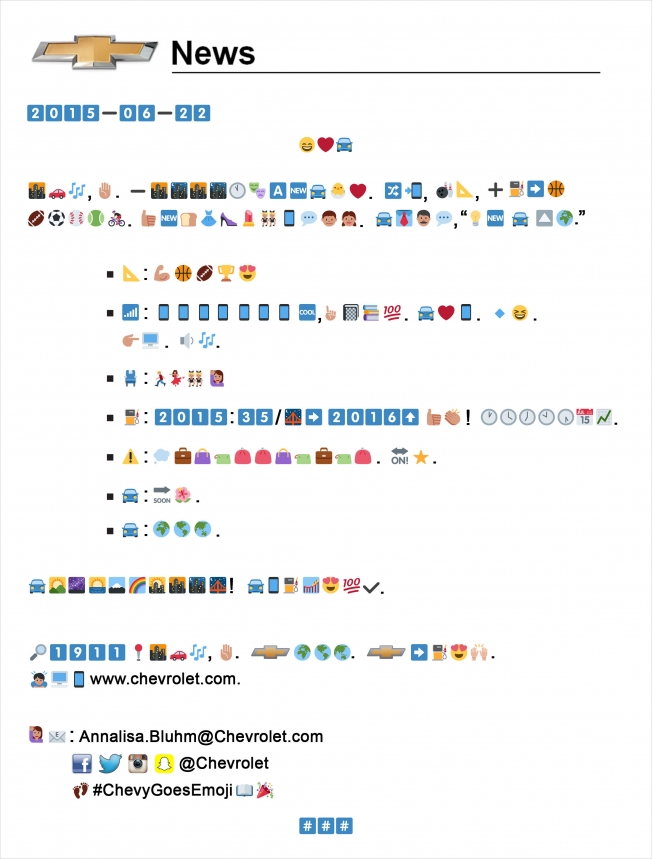 Photo via Adweek
Photo via Adweek
In summary, emojis are here to stay. Marketers and lay users utilize them, and they add a welcome pop of color and visual interest to otherwise blah black-and-white copy. However, emojis may have many different meanings, some of which may be inappropriate, offensive, or just plain weird.
If you’re starting to incorporate emojis into your marketing messaging for the first time, do your research, choose unique emojis that align with your messaging, and please, don’t use them too much.
Of course, if you’re still about using these little pictures in your marketing messaging, we’re here to help. A wide majority of our staff are fluent in emoji, and a select few helped write the Rosetta Stone course. Facetiousness aside, our social media experts can help you strategically infuse your current messaging with personality via present and emerging tools like emojis, filters, hashtags, and more.
Want to take your messaging from 💩 to 💎? Slide into our DMs on Facebook or give us a 📞at 920.983.9700 pronto!
THE 🔚.
*Guys, I really don’t think that’s what’s going on … why would they both be wearing the exact same shirt and have matching skin tones? #FakeNews
